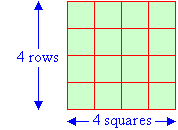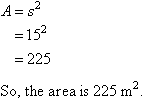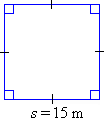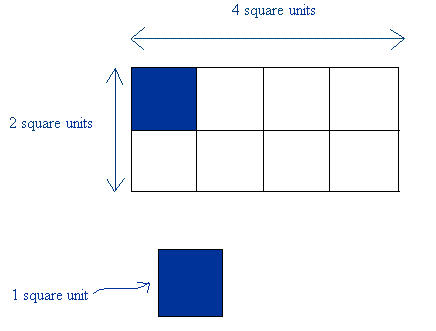Thursday, November 22, 2012
AREA
Area of a SquareThe area of a square that has a side-length of 1 cm is 1 square centimetre (or 1 cm2). To find the area of a square by the method of counting squares, we divide the square into smaller squares of one centimetre side-length . Consider a square that has a side-length of 4 cm.  Using the method of counting squares, we find that the area of the square is 16 cm2. Clearly, the square contains 4 rows of 4 squares. Therefore:
The area of a square is equal to its side-length multiplied by its side-length. That is: | |
 |  |
To find the area of a region enclosed within a plane figure, draw a diagram and write an appropriate formula. Then substitute the given values and use a calculator, if necessary, to obtain the required area. | |
| Perimeter |  |
| A square and an equilateral triangle are both examples of regular polygons. Another method for finding the perimeter of a regular polygon is to multiply the number of sides by the length of one side. Let's revisit Examples 3 and 4 using this second method. | ||
| Example 3: | Find the perimeter of a square with each side measuring 2 inches. | |
| Solution: | This regular polygon has 4 sides, each with a length of 2 inches. Thus we get: | |
| Example 4: | Find the perimeter of an equilateral triangle with each side measuring 4 centimeters. | |
| Solution: | This regular polygon has 3 sides, each with a length of 4 centimeters. Thus we get: | |
| Example 5: | Find the perimeter of a regular pentagon with each side measuring 3 inches. | ![[IMAGE]](http://www.mathgoodies.com/lessons/vol1/images/pentagon.gif) |
| Solution: | ||
| Example 6: | The perimeter of a regular hexagon is 18 centimeters. How long is one side? | ![[IMAGE]](http://www.mathgoodies.com/lessons/vol1/images/regular_hexagon.gif) |
| Solution: | ||
| Let | ||
| Summary: | To find the perimeter of a polygon, take the sum of the length of each side. The formula for perimeter of a rectangle is: | |
| Perimeter Part I |  |
| The perimeter of a polygon is the distance around the outside of the polygon. A polygon is 2-dimensional; however, perimeter is 1-dimensional and is measured in linear units. To help us make this distinction, look at our picture of a rectangular backyard. The yard is 2-dimensional: it has a length and a width. The amount of fence needed to enclose the backyard (perimeter) is 1-dimensional. The perimeter of this yard is the distance around the outside of the yard, indicated by the red arrow; It is measured in linear units such as feet or meters. | ![[IMAGE]](http://www.mathgoodies.com/lessons/vol1/images/fence_perimeter.gif) | |
| To find the perimeter of a polygon, take the sum of the length of each side. The polygons below are much smaller than a fenced-in yard. Thus, we use smaller units in our examples, such as centimeters and inches. | ||
| Example 1: | Find the perimeter of a triangle with sides measuring 5 centimeters, 9 centimeters and 11 centimeters. | ![[IMAGE]](http://www.mathgoodies.com/lessons/vol1/images/scalene_triangle.gif) |
| Solution: | P = 5 cm + 9 cm + 11 cm = 25 cm | |
| Example 2: | A rectangle has a length of 8 centimeters and a width of 3 centimeters. Find the perimeter. | |
| Solution 1: | P = 8 cm + 8cm + 3 cm + 3 cm = 22 cm | |
| Solution 2: | P = 2(8 cm) + 2(3 cm) = 16 cm + 6 cm = 22 cm | |
| In Example 2, the second solution is more commonly used. In fact, in mathematics, we commonly use the following formula for perimeter of a rectangle: | ||
| In the next few examples, we will find the perimeter of other polygons. | ||
| Example 3: | Find the perimeter of a square with each side measuring 2 inches. | |
| Solution: | ||
| Example 4: | Find the perimeter of an equilateral triangle with each side measuring 4 centimeters. | |
| Solution: | ||
Perimeter worksheet 1
Remember: Perimeter is the total distance around the outside of a 2D shape.You calculate it by adding together all the lengths of a shape.
Work out the perimeter of these shapes:
1. A rectangle 7cm long by 8cm wide.
2. A square with one side 15cm long.
3. A rectangle 20cm by 30cm.
4. A 32cm by 10cm rectangle.
5. A rectangle 75cm long by 25cm wide.
6. A 50cm by 50 cm square.
7. A rectangle 16cm by 12cm.
8. A 63cm by 25cm rectangle.
9. A square with one side measuring 45cm.
10. A rectangle 19cm long by 5cm wide
Exercise 2
Find the area and perimeter of each rectangle.
Remember to include the units in your answers.
(For example, m or square m)
1. 18 m wide, 23 m long
perimeter =
area =
2. 39 in wide, 30 in long
perimeter =
area =
3. 10 ft wide, 15 ft long
perimeter =
area =
4. 23 cm wide, 21 cm long
perimeter =
area =
5. 27 mm wide, 10 mm long
perimeter =
area =
6. 13 m wide, 46 m long
perimeter =
area =
7. 11 ft wide, 31 ft long
perimeter =
area =
8. 49 in wide, 8 in long
perimeter =
area =
9. 16 cm wide, 29 cm long
perimeter =
area =
10. 40 mm wide, 16 mm long
perimeter =
area =
HOW TO FIND THE ARES
To get the amount of space inside a figure, we use a square to represent 1 unit and we say that the area is measured in square units
Take a look at the following rectangle. To get the area, we are going to draw squares of equal sizes inside of it.

1 square represents 1 square unit. The rectangle has 8 squares, so the area for this rectangle is 8 square units.
We can also write 8 units2 and it will mean the same
Notice,it is very important, that you can get the same answer if you multiply 2 square units by 4 square units because 2 × 4 = 8
2 square units represent the measure of the width and 4 square units represent the measure for the length.
Thus, in general, to get the area for a rectangle, just use the following formula:
Area of rectangle = length × width
Take a look at the following rectangle. To get the area, we are going to draw squares of equal sizes inside of it.

1 square represents 1 square unit. The rectangle has 8 squares, so the area for this rectangle is 8 square units.
We can also write 8 units2 and it will mean the same
Notice,it is very important, that you can get the same answer if you multiply 2 square units by 4 square units because 2 × 4 = 8
2 square units represent the measure of the width and 4 square units represent the measure for the length.
Thus, in general, to get the area for a rectangle, just use the following formula:
Area of rectangle = length × width
Subscribe to:
Posts (Atom)